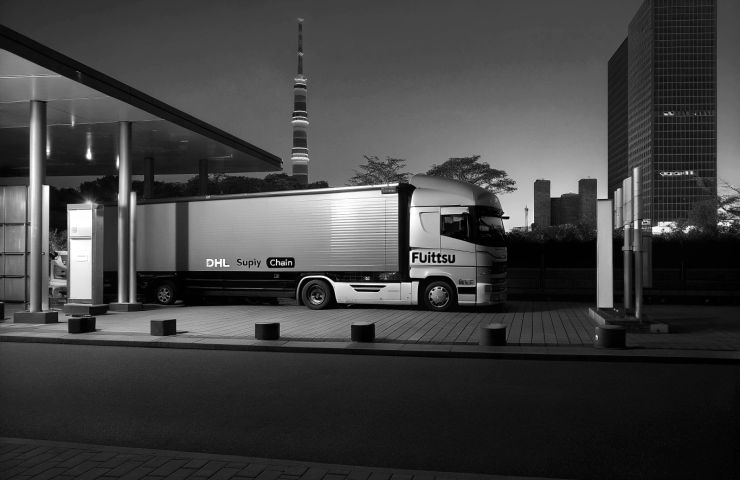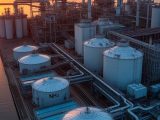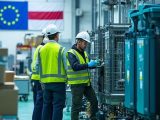
DHL Supply Chain Tests Hydrogen Fuel Cells in Japanese Logistics
August 8, 2025Ever thought about a cargo truck slipping through Tokyo’s buzzing streets, leaving zero tailpipe smoke behind? That’s exactly what DHL Supply Chain is up to. They’ve rolled out a pilot of trucks powered by hydrogen fuel cells across the metro, ferrying loads between their hubs and Fujitsu Limited sites. It’s a quiet revolution—no roar, no fumes, just a slick truck cruising by like tomorrow peeking around the corner.
This whole setup’s basically a public-private tag team, putting zero-emission technology through its paces in everyday shipping. Kicked off in August 2025, the project taps into Japan’s Green Innovation Fund Project, with Commercial Japan Partnership Technologies Corporation (CJPT) steering and cash from the New Energy and Industrial Technology Development Organization (NEDO). Then there’s Sumitomo Mitsui Banking Corporation, playing matchmaker and green lender, smoothing out upfront costs with some slick ESG-linked loans. On the street, these trucks pack hydrogen fuel cells and haul everything between companies, logging real-world tidbits—range, refueling speed, upkeep notes, driver thumbs-up or downs. The big ask? Prove hydrogen’s up to the heavy lifting and prime the pump for hydrogen infrastructure and rules that let this tech really take off.
The Technology Behind the Trucks
Ever wondered how hydrogen fuel cells power these beasts? Picture an EV with its own power plant tucked inside. Multiple high-pressure tanks store hydrogen gas that slides into a fuel cell stack and meets oxygen over a catalyst. Boom—a chemical reaction generates electricity, with water vapor (and a bit of heat) as the only byproducts. That juice spins electric motors—no combustion, no particulates. These rigs clock about 260 km per fill, right on par with their diesel kin on city runs. And topping off takes just 15 to 20 minutes, not an overnight charge. Sure, the tanks add some heft, but modular designs keep the extra kilos from eating into cargo space. The result? A whisper-quiet juggernaut that turns busy depots into calm, clean zones.
Business Context
So, why’s DHL Supply Chain throwing its hat into hydrogen now? Partly, it’s about hitting sustainability milestones. Under its Strategy 2030, DHL Group aims for 30% of its air, sea and road energy to come from sustainable fuels by 2030. They’ve already run electric vans and played around with sustainable aviation fuel, but now it’s heavy-duty trucks’ turn. In Japan—a maze of tight streets and nonstop deliveries—they see a prime spot to pioneer green logistics. First movers snag sweet deals on clean energy, scoop government incentives, and polish a low-carbon image. And clients like Fujitsu—gearing up for net zero by 2040 under its Climate & Energy Vision—get to brag about shrinking their footprint. It’s a classic win-win: DHL fast-tracks its industrial decarbonization roadmap, and customers look good doing it.
Why Japan?
Why pick Japan? It’s not just a pretty backdrop—it’s ground zero for the hydrogen economy. The country imports almost all its energy, packs millions into tight spaces, and demands top-tier air quality. Going fossil-free isn’t optional; it’s essential. The government’s pumped billions into hydrogen production, hydrogen infrastructure, and fueling stations, eyeing a full-scale supply chain by 2030. Stations are popping up in Greater Tokyo, Osaka, and Aichi, thanks to NEDO subsidies. They’ve even carved out regulatory sandboxes so companies can test-drive zero-emission technology without drowning in red tape. It’s a hotbed of innovation—automakers, energy outfits, and logistics pros teaming up on everything from fuel cell buses to warehouse forklifts. That’s exactly the challenge DHL’s pilot needs: real-world traffic snarls and tight delivery slots.
Collaboration and Finance
This isn’t a solo sprint—it’s a relay with heavy hitters. Commercial Japan Partnership Technologies Corporation (CJPT) has Toyota, Isuzu, Hino, Suzuki, and Daihatsu hashing out next-gen vehicle standards. NEDO chips in with R&D grants and infrastructure funding. DHL Supply Chain brings operational know-how and trains the drivers, while Fujitsu Limited adds energy management systems and data analytics to fine-tune performance. On the money side, Sumitomo Mitsui Banking Corporation covers costs with ESG-linked loans, ensuring every yen aligns with climate targets and risk checks. Pooling resources lets everyone dodge the sting of upfront expenses—fuel cell stacks, pressurized tanks, pumps, you name it. And the data we gather? It’ll make round-two financing a breeze. It’s an ecosystem play: tech, logistics, policy, and finance all synced up to champion sustainable energy and light the way on industrial decarbonization.
Environmental and Supply Chain Ripples
On the environmental side, hydrogen fuel cell trucks deliver a double whammy: slashing CO₂ and scrubbing particulate emissions that gum up city air. Less smog, fewer coughs—that’s instant community relief. But the real magic shows up in the supply chain. Every kilo of hydrogen burned sends a signal to producers, spurring growth in green hydrogen production—ideally from renewable-powered electrolysis, not fossil feedstocks. As volumes climb, prices fall, making hydrogen an even sweeter deal across industries. And those new refueling stations? They become hubs for whole fleets, from taxis to delivery vans. Picture a network of pumps powering everything, from warehouse forklifts to big rigs on the expressway. That’s the network effect that turns a pilot into a full-scale revolution—planting seeds for tomorrow’s clean energy forest.
Looking Ahead
So, what’s next when the dust settles? If the numbers look good—economically and environmentally—you’ll see more hydrogen trucks weaving through Japan’s logistics corridors. Then comes the expansion: long-haul cross-border runs linking Japan to neighbors chasing their own decarbonization goals. And it’s not just a Japan story—lessons here will guide pilots in Europe, North America, and beyond. Sure, there are speed bumps ahead—ensuring hydrogen stays low-carbon at scale, syncing up safety regulations, and beefing up that hydrogen infrastructure. But this pilot lays the tracks: smart public-private partnerships, shared financing, and real-world data. Draw those lines together, and it’s clear: the future of heavy-duty logistics might just hinge on these modest fleets proving big ideas, driving forward sustainable energy and industrial decarbonization.
At the end of the day, DHL Supply Chain’s trial isn’t just a fleet test—it’s a statement. It shouts that heavy-duty logistics are ready to roll into a new zero-emission technology era—one whisper-quiet, high-torque truck at a time.



 With over 15 years of reporting hydrogen news, we are your premier source for the latest updates and insights in hydrogen and renewable energy.
With over 15 years of reporting hydrogen news, we are your premier source for the latest updates and insights in hydrogen and renewable energy.